While White Nationalist critics of Christianity will point to the Church’s willingness to promiscuously baptize all comers as an obvious gap in the Church’s armor, they don’t take their criticism nearly far enough. Rather, instead, the symbolism of Baptism was from its origin a metaphor for racial cuckoldry. Hence even when the policy of baptizing converts doesn’t function directly in the process of permitting racial dissolution, as a symbol, it promotes this direction esoterically, subconsciously. It is JED (Jewish Esoteric Demoralization) to be sure.
This might be understood as particularly upsetting to the “White Nationalist Christian,” as Jesus’ title, Christ, is itself a reference to Baptism. Indeed, it is derived ultimately from the Greek Khristos adjective meaning “anointed.” This is a reference to Christ’s Baptism by John.
The Hebrew title Messiah shares the meaning of the title Christ. Messiah is derived from the Hebrew mashah, משה, meaning “anoint.” The name Moses, מֹשֶׁה is closely related to the word Messiah and, in my estimation, should be considered synonymous.
Indeed, in Exodus 2:10 it is indicated Moses gained this name because he was drawn out of the Nile River. Typically, it is guessed this is so because the word used in the Hebrew mesitihu, מְשִׁיתִֽהוּ, for the expression “I drew him,” shares similarities to the name Moses. Yet considering the narrative more broadly, certainly we should regard Moses placement in the Nile and Christ’s Baptism in the Jordan as symbolically close.
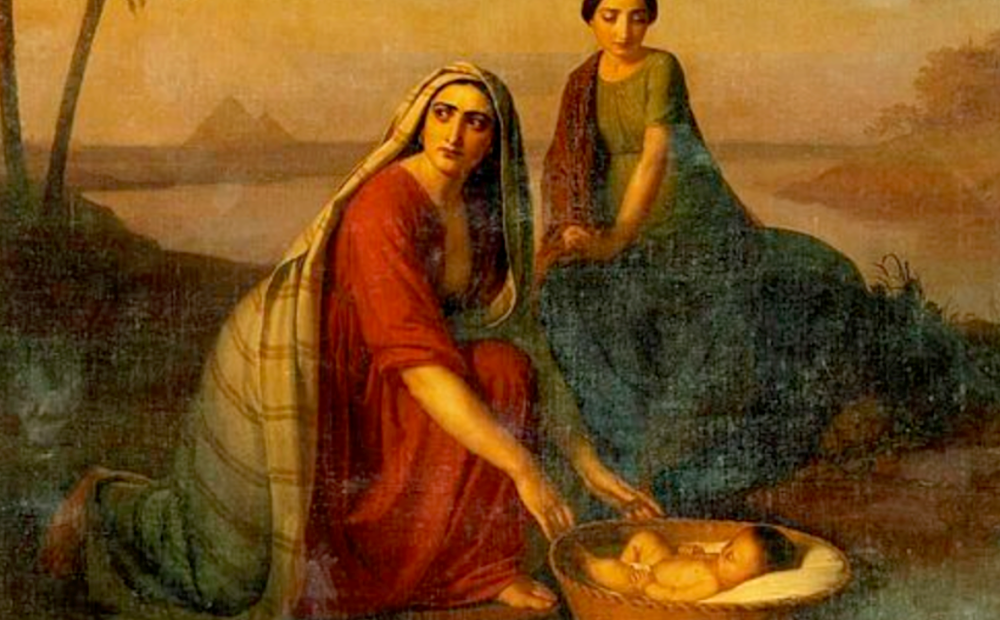
Indeed, in Exodus 2:10 it is indicated Moses gained this name because he was drawn out of the Nile River.
To wit, in both cases, a Jewish figure is metaphorically entering or “being baptized” in the vagina or ancestral blood of Aryans. Again, the symbol of fresh water, generally, as mentioned, may be understood as associated with Aryan blood or Ab as well as with the vaginal or feminine.
Hence, in a sense, both Moses and Jesus Christ are racial cuckoldry incarnate. Here we understand plainly that “salvation of the Jews” in the Hebrew Bible was the same as “salvation of the Jews” in the New Testament. “Salvation” is admixture with Aryans.
As this study explicates, the Jordan River, the site of Christ’s baptism, is itself a symbol for the Semitization of the Aryan. Here fresh waters run to salt waters, the fresh waters from the Aryan Regions of Ancient Israel to the Jewish Region of Judea abutting the Dead Sea. Here, again, salt is the Semitic, earthy, life-destroying element.
Likewise, the details of the Baptism narrative support this conclusion. There is for instance the dove that visits Christ during his Baptism that is understood as the “Holy Spirit.” The Dove also was a symbol of the Aryan Venus. Though, “the Holy Spirit,” is also a reference to the beautiful Psyche, a clear Aryan figure and essentially a Symbolic Synonym of Venus Urania.
Here we understand that a celestial Aryan spirit or woman descends to the earthy Semite. Descending from Heaven upon Christ a voice accompanying the Dove says: “You are my dearly loved son; you bring me great joy” or “You are my Son, the Beloved; with you I am well pleased.” [1]This is Venus, mother and lover, speaking to the beloved Adonis, son and lover. In the Gospel of Luke it says “heaven was opened, and the Holy Spirit descended on Him in a bodily form like a dove.”[2]
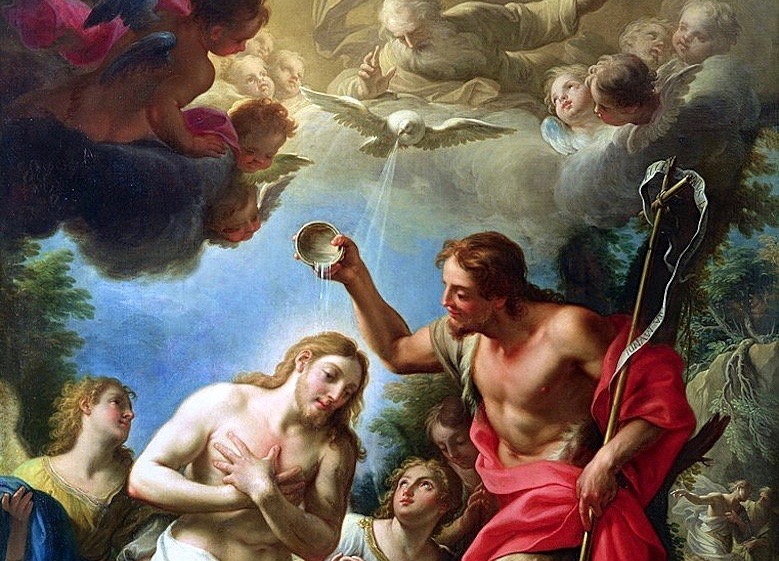
As far back as Sumer, the Semitic Sargon of Akkad, a clear model of Moses, David and Christ, encounters Inanna/Ishtar in the “Garden of the Gods” enclosed in a cloud of doves. Like Moses, Sargon too was “anointed” in a river, in a basket of bulrushes. For the duration of his long life he called himself “The anointed priest of Anu.”
The dove’s significance to Noah’s search for land whilst he is adrift in the ark likewise has sexual and racial significance. When it returns with an olive branch, Noah, amid a salted, Semitized sea of racial chaos, albeit meaningfully protected in a wooden ark, understands that a land with women of useful racial stock has been discovered. Again, we see the Bride Gathering Cult.
Indeed, the famous expression to be “wise as serpents, and simple as doves”[3] itself is suggestive of this pairing of the Semitic “Bacchus” and the Aryan “Venus” as if, indeed, this was largely the composition of Christ’s original Galilean flock. It was comprised of Jewish male “serpents” and Aryan female “doves.” Here we find Woodstock c. 1st century A.D. Here they are given words of wisdom as Christ sends them out “amidst wolves.”[4] As this study explicates, wolves are an Aryan identifier in the JEM.
John the Baptist is often depicted as baptizing Jesus with a scallop shell. This is meaningful. The scallop, along with other hinged seashells, was used as a symbol of female sexuality throughout antiquity. It is frequently found in Venus Anadyomene or ancient iconic depictions of “Venus Rising from the Sea.” The most famous to modern readers will be Sandro Botticelli’s painting “The Birth of Venus.” Here the scallop is understood as a symbol of the female vulva. Indeed, the crass modern expression of “clam,” carrying the same meaning, may have arrived consciously through a “Promethean transmission.”
Symbolically, during the baptism, Christ is being doused by water from the Aryan Venus’ vulva, hence intercourse is indicated. On the other hand, ostensibly, it is the birth of Adonis or Christ, through Venus’ or Mary’s vulva. Indeed, after all, we understand the Baptism to represent something of a “rebirth.” In any case, Baptism is a symbol in the New Testament of racial intermixture.
Here, esoterically, we understand “Baptism” or reproduction with Aryan women as a means to salvation and access to heaven. Here the “Aryan dove” we understand as a lofty, descending power, like Mary, of “immaculate conception.” Likewise, we can understand Baptism as a “cleansing of sins” or “purification.” Hence there appears here esoterically a confession that, indeed, the “purer” Aryan race is a source of racial and even moral purity. Mixing with Aryans is a way of becoming “clean” or “cleaner,” returning to Eden.
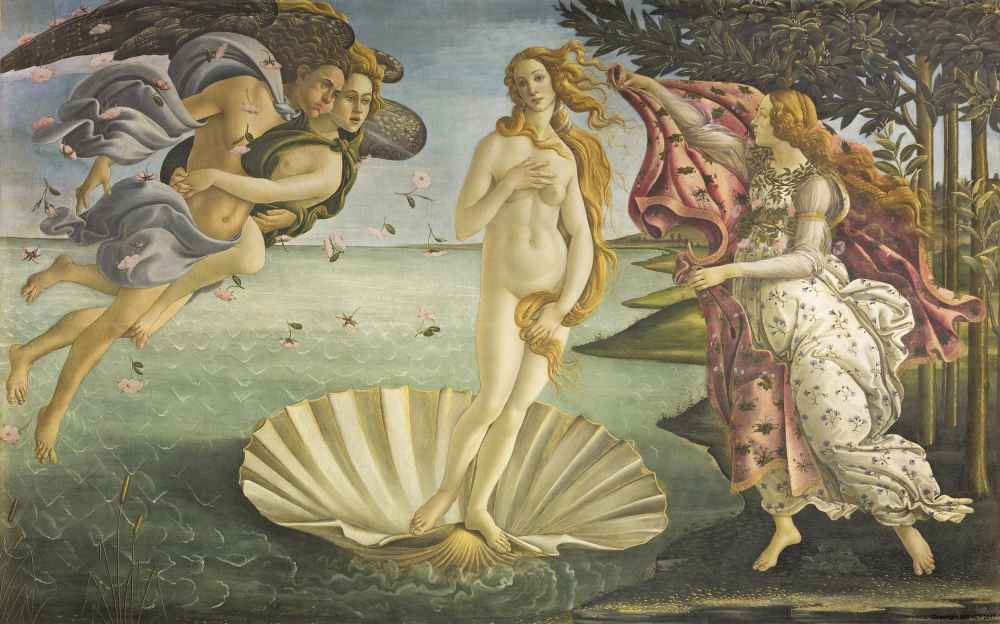
Here one creates “less sinful” offspring through reproduction with an Aryan woman. As the Negro always desires fairer children, so does the Jew. Thus, here, the Aryan womb becomes the means of salvation in Christianity or, rather, the Jewish means to salvation. This could only be used to supports my etymological speculations on the word “sin” as it appears in the Biblical context via “Promethean Transmission.” To wit it is related to the Semitic Moon God Nanna/Sin. The setting of the river of the Baptism too harkens to the Semitic Enlil’s seduction of the Aryan Ninlil where Nanna/Sin was conceived.
Hebrew too perhaps contains clues on the meaning of the baptism ritual. The word, lehatbil, לְהַטְבִּיל, means “baptize,” “immerse,” “dip,” “douse,” “sop” and “Christen” in the Modern Hebrew. It conforms to the original meaning of the word Baptism as it developed from the Greek baptizein. However elsewhere we find a Hebrew word that conflates the notion of impregnation with immersion in water. L’haspiyg, לְהַספִּיג, for instance, means “impregnate,” “soak,” ”sop” and “steep” in the Modern Hebrew. There is also the curious Hebrew word Amah, אָמ which means “aqueduct” or “canal” as well as “maid” and “maid servant.” This seems to be providing a similar metaphor. Amah used with its aqueous meanings appears commonly in Mishnaic Hebrew but not in the Hebrew Bible.
Clues as to the significance of Baptism in the New Testament also appear in the personage of John the Baptist. Here John the Baptist, a priest ostensibly descended of Aaron, appears almost as a mentor for Christ in, frankly, his search for Aryan women in the ripe “Sea of Galilee.” Perhaps it is suggested because John the Baptist is a priestly descendant of Aaron, he too possess a powerful, “magical rod.” Perhaps he is indicated as a pimp of sorts, if also a “priest.” That his only “food was locusts and wild honey”[5] is also suggestive.
The wild honey metaphor is clear, the locust less so. However often it is suggested that “locust” is a reference to the sweet carob fruit often know as “St John’s bread,” “locust bean” and “locust-tree.” The Modern Hebrew word for carob, charul, חָרוּב, also means locust. In the Hebrew Bible charul is generally surmised to mean “chickpea” or “weeds.”
There is also a curious word in Modern Hebrew, gab, גֵב, which may mean “waterhole,” “pit,” “board,” “plant” or “locust.” All of the definitions, aside from “locust,” are arborous or aqueous, and may be understood as references to the Aryan. In the Hebrew Bible, gab carries the meaning “back (of a person)” and “mound (for illicit worship).” The related word, gabar, גוֹב, may mean “den,” “pit” and “locust” in the Modern Hebrew.
Regardless, John the Baptist is esoterically suggested in the New Testament as a womanizer. Here, again, Judaism becomes the original PUA cult, where men who are otherwise sexually uncompetitive, develop techniques and “mystery,” perfumes, “colognes,” helpful teammates, “philosophy,” perhaps narcotics and entire “mystery religions” as equalizers. This is the Eastern Guru and male Yoga instructor on an entirely different level. One might call it pathetic and absurd had it not succeeded in the unfathomably profound manner that it would. Consider this tendril of the Jewish PUA cult called Christianity has been accepted as the most sacred mystery Religion by Aryans for close to two thousand years. Talk about living vicariously.
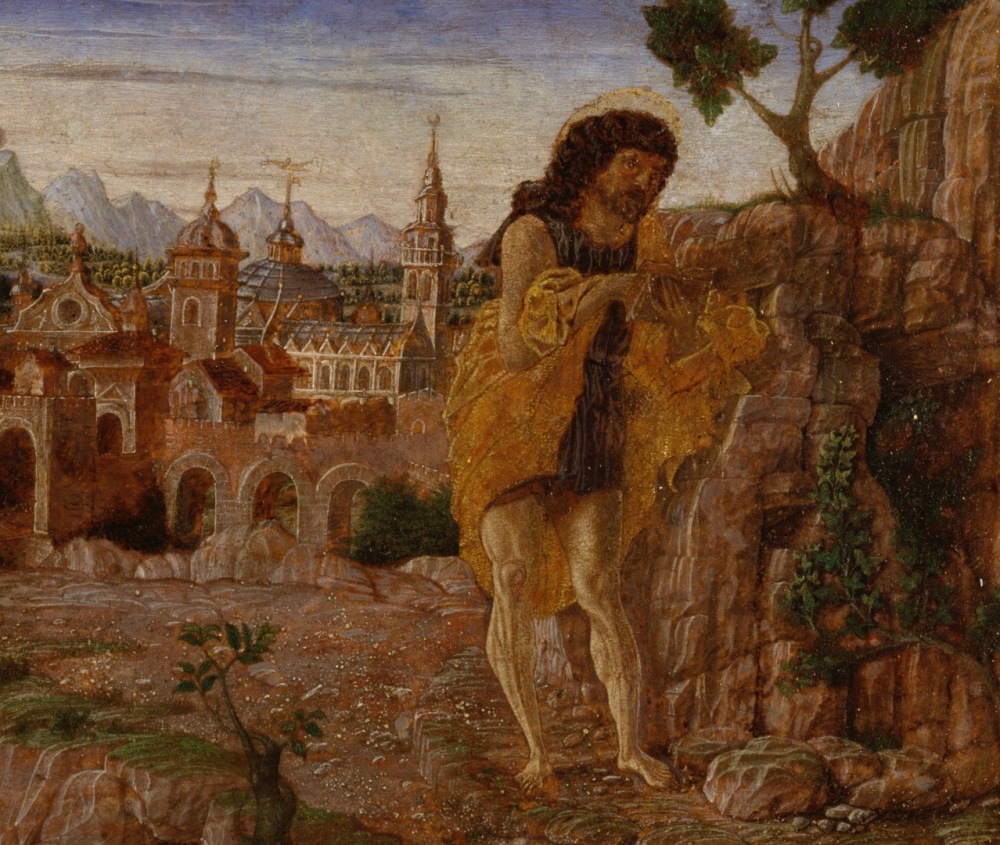
As this study explicates, the name John becomes a common ethnic identifier in the contemporary JEM. Indeed, perhaps it is the most common. Thus, by this name, characters are indicated not merely as Jewish but also as “baptizing” or intermixing or seeking to intermix with Aryan women like John “the Baptist.” The name John comes from the Hebrew name Yochanan, יוֹחָנָן, meaning “priest.” This is befitting of a Levite descended of Aaron, patriarch of the Jewish priest class. Here we must understand the adoption of a persona like “priest” or “philosopher” as sexual strategy whether witting or unwitting. One dons gowns and effeminate gestures, circumcises and falsely emasculates or feminizes oneself so as to approach desired breeding stocks in a disorienting and unthreatening manner, whether homosexually or heterosexually.
That Christ’s symbol is the ichthys is also meaningful. Here he’s suggested, like Peter and his apostles, as the “Fisher of Men.” To be clear, here, in Aryan Galilee, in the seat of Christ’s ministry, they are understood as Fishers of the Sea of Galilee where the “waters are fertile.” In Judea, next to the Dead Sea, there isn’t a fish to be found, only salt and presumably salty women. As covered elsewhere in this study, the ichthys represents the Aryan as consumable resource. Specifically it is a reference to the Aryan Venus fleeing the Semitic Typhon, son of Saturn.
The anointing that occurs in the Biblical works and in Jewish ritual generally, by oils and perfumes, should also be viewed through an understanding developed here. For instance, recorded in all four Gospels, Christ is understood to have received a lavish anointing by a woman presumed to be Mary prior to his crucifixion. This is also a veiled reference to intercourse with the Aryan Venus. The washing of Jesus’ “feet,” as explicated in this study, becomes a euphemism.
Likewise, when we understand Myrrha as a synonym for Mary and the Aryan Venus, we understand as well that Myrrh oil, carries a double meaning. Indeed, Myrrha oil is used as anointing oil in both Bibles. Likely this practice of anointing was itself a kind of “Venus worship” among Jewish men, symbolizing sexual penetration.
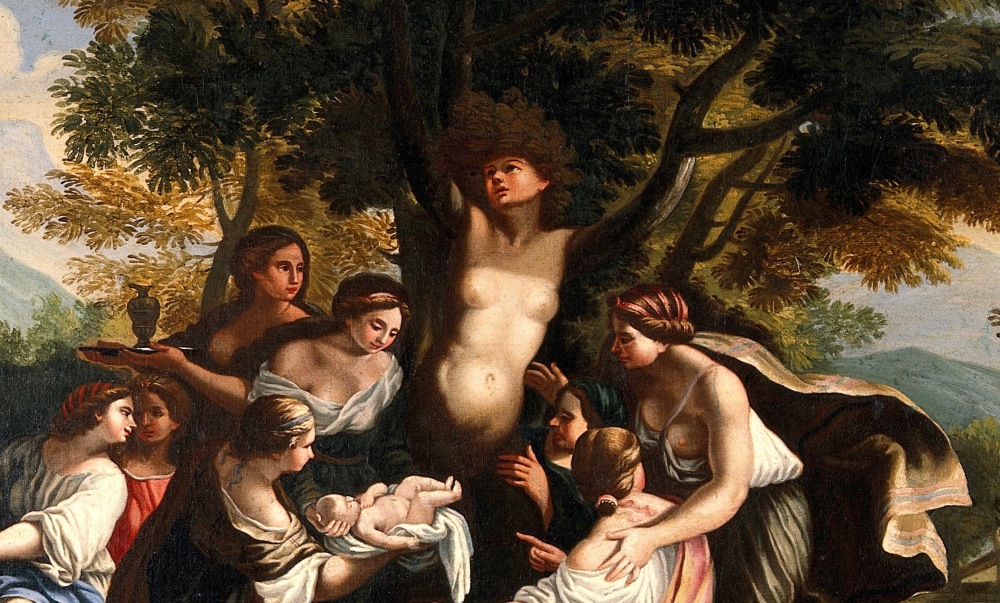
Perhaps consistent with JEM more broadly it was a kind of secret mocking of local Aryan men, entirely unaware of these meanings. Its use in perfume here suggests it was also a kind of attractant or cologne by which the “waters or myrrh oil of Venus” might be acquired. As this study explicates, tree resins and tree extracts, such as olive oil, become symbols in JEM for sexual accessibility among Aryans.
The holy anointing oil, shemen ha-mishchah, שמן המשחה, used by the Jewish priesthood is translated as “oil of anointing,” with ha-mischah translating as “ointment” or “unguent” in the Modern Hebrew. However Shemen may translate as “fat,” “fleshy,” “robust,” “buxom,” “thick” and “fertile.” The word is also translated as “fertile” on four occasions in the Hebrew Bible while oil or ointment 180 times. This likely suggests the vaginal.
In Exodus 30:22-25 the holy anointing oil is described as created from five different substances. These substances are sweet cinnamon, Kaneh bosem, cassia, olive oil and myrrh or mar deror, מר דרור. Deror here translates as “liberty” and “freedom” in the Hebrew Bible but also “sparrow” and “swallow” in the Modern Hebrew. The sparrow was a bird sacred to Venus and understood as an erotic symbol or a symbol of sexual “liberty.” Here we may begin to develop an understanding regarding the name meaning of “rebelliousness” for the name Mary.
Most of the arboreal ingredients of the holy anointing oil might be understood as references to Aryan stock. The olive tree was sacred to Minerva and cinnamon was an offering made to the Aryan God Apollo. Hence anointing, again, becomes a metaphorical sex act. Kaneh bosem, argued by contemporary scholars to be a reference to marijuana, is possibly, instead, a phallic symbol. It translates as “fragrant reed,” “fragrant rod” or “fragrant cane.” The reed as a symbol is a symbol of the Semitic Bacchus, for example, while the rod a symbol of Aaron.
These matters are discussed here:
[1] Mark 1:11
[2] Luke 3:21-3:22
[3] Matthew 10:16
[4] Matthew 10:16
[5] Matthew 3:4
10 thoughts on “Baptism and Anointing: Symbols for Copulation and Sexual Interaction”